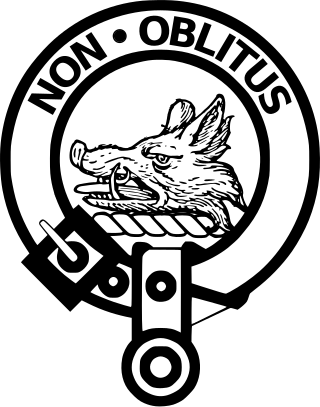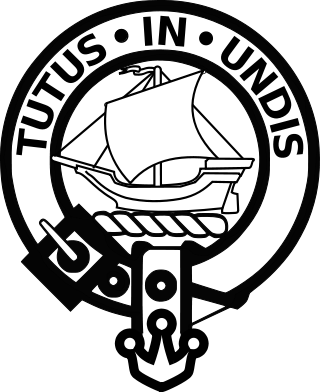This article needs additional citations for verification .(November 2009) |
Christie is a sept of Clan Farquharson, a Highland Scottish clan of Invercauld, Aberdeenshire.
This article needs additional citations for verification .(November 2009) |
Christie is a sept of Clan Farquharson, a Highland Scottish clan of Invercauld, Aberdeenshire.

Christie is a shortened form of Christian and possibly also of Christopher, which is established in Fife and Stirlingshire [1] According to Scots Kith and Kin, Clan Christie was in the area of Fife in the 15th century. Said to be a sept of the Clan Farquharson. Another tradition is that the name was given to descendants of Christianus, a younger son of Alwyn II, one of the first Earls of Lennox. [2] Anderson describes four coats of arms belonging to four different Christie families in Fife, Mid-Lothian, Aberdeen, and Galloway. Rogers [3] states that the name may have come from the Danish word "cruset" which means "cup"; and there was a family of Christie on the Isle of Man, who claimed descent from the Danes. Anderson[ citation needed ] reports that the last recognized head of the Clan Christie was Sir Archibald Christie who was deputy-governor of Stirling Castle, and who died in 1847.
The Christy family first appears in the records of Edinburghshire where they were recorded as an ancient Edinburghshire family before the year 1100. The most ancient Christy family coat of arms was recorded between the 12th and 15th centuries. The notable Christy family is shown in the ancient manuscripts and cartularies as tracing their ancestry to Pictish origin.
Christy, Chrystie, Chrysty, MacChristie, McChristie, MacChristy, McChristy, Christe, Christi, Cristi, MacChrystyn, McChrystyn, Christian, and many more.

Clan MacLeod is a Highland Scottish clan associated with the Isle of Skye. There are two main branches of the clan: the MacLeods of Harris and Dunvegan, whose chief is MacLeod of MacLeod, are known in Gaelic as Sìol Tormoid ; the Clan MacLeod of Lewis and Raasay, whose chief is MacLeod of The Lewes, are known in Gaelic as Sìol Torcaill. Both branches claim descent from Leòd, who lived in the 13th century.
Leod was the eponymous ancestor and founder of Clan MacLeod and Clan MacLeod of Lewis. Almost nothing is known about him and he does not appear in any contemporary records. Tradition dating to the late 18th century made him a son of Olaf the Black who was King of Man. Heraldic evidence, dating to the late 17th century, is considered to be the earliest evidence of descent from Olaf the Black. However, in recent years, this traditional lineage has been challenged and is no longer considered fact by one historian.

Clan MacNeil, also known in Scotland as Clan Niall, is a highland Scottish clan of Irish origin. According to their early genealogies and some sources they're descended from Eógan mac Néill and Niall of the Nine Hostages. The clan is particularly associated with the Outer Hebridean island of Barra. The early history of Clan MacNeil is obscure, however despite this the clan claims to descend from the legendary Irish King Niall of the Nine Hostages, who is counted as the 1st Clan Chief, the current Clan Chief being the 47th. The clan itself takes its name from a Niall who lived in the 13th or early 14th century, and who belonged to the same dynastic family of Cowal and Knapdale as the ancestors of the Lamonts, MacEwens of Otter, Maclachlans, and the MacSweens. While the clan is centred in Barra in the Outer Hebrides, there is a branch of the clan in Argyll (McNeill/MacNeill) that some historians have speculated was more senior in line, or possibly even unrelated. However, according to Scots law the current chief of Clan MacNeil is the chief of all MacNeil(l)s.

Clan Shaw is a Highland Scottish clan and is a member of the Chattan Confederation.

Irish clans are traditional kinship groups sharing a common surname and heritage and existing in a lineage-based society, originating prior to the 17th century. A clan included the chief and his patrilineal relatives; however, Irish clans also included unrelated clients of the chief.

Clan Anderson is a Scottish clan that is recognized as such by the Lord Lyon King of Arms. However, as the clan does not currently have a chief recognized by the Court of the Lord Lyon, it is therefore considered an armigerous clan. Variations of the surname are however considered septs of several other clans of the Scottish Highlands: The surname MacAndrews is considered a sept of the Clan Mackintosh and Clan Chattan, and also associated with the Clan MacDonell of Glengarry. The surnames Andrew and Andrews are considered septs of the Clan Ross.

Clan Buchanan is a Highlands Scottish Clan whose origins are said to lie in the 1225 grant of lands on the eastern shore of Loch Lomond to clergyman Sir Absalon of Buchanan by the Earl of Lennox.

Clan MacTavish is an Ancient Highland Scottish clan.

Clan Macfie is a Highlands Scottish Clan.

Clan MacAulay, also spelt Macaulay or Macauley is a Scottish clan. The clan was historically centred on the lands of Ardincaple, which are today consumed by the little village of Rhu and burgh of Helensburgh in Argyll and Bute. The MacAulays of Ardincaple were located mainly in the traditional county of Dunbartonshire, which straddles the "Highland Line" between the Scottish Highlands and Lowlands. Clan MacAulay has been considered a "Highland clan" by writers and has been linked by various historians to the original Earls of Lennox and in later times to Clan Gregor. The MacAulays of Ardincaple, like Clan Gregor and several other clans, have traditionally been considered one of the seven clans which make up Siol Alpin. This group of clans were said to have claimed descent from Cináed mac Ailpín, King of the Picts, from whom later kings of Scotland traced their descent. The chiefs of Clan MacAulay were styled Laird of Ardincaple.

Clan Wood is a Lowland Scottish clan from North Esk, Largo Bay and Angus in Scotland.

Clan MacEwen or Clan MacEwan is a Scottish clan recorded in the fifteenth century as Clan Ewen of Otter.

The O'Neill dynasty are a lineage of Irish Gaelic origin that held prominent positions and titles in Ireland and elsewhere. As kings of Cenél nEógain, they were historically one of the most prominent family of the Northern Uí Néill, along with the O'Donnell dynasty. Some O'Neills state that their ancestors were kings of Ailech during the Early Middle Ages, as descendants of Niall of the Nine Hostages.
Corrin is a surname of Gaelic origin. It is a contraction of MacCorran or McCorryn, an anglicised form of the Gaelic MacTorin, meaning "son of Thórfinnr". The surname is also a contraction of Mac Odhráin or fuller Mac GilleOdrain. This surname is considered to be an patronymic name, meaning "son of Odhran". The personal name Odhrán means "pale-faced" or "the little pale-faced one". Corrin may also represent anglicized forms of Mac Corraidhin, meaning "little spear".

A Scottish crest badge is a heraldic badge worn to show allegiance to an individual or membership in a specific Scottish clan. Crest badges are commonly called "clan crests", but this is a misnomer; there is no such thing as a collective clan crest, just as there is no such thing as a clan coat of arms.

Clan McCorquodale is a Scottish clan, recognised by the Lord Lyon King of Arms, though without a chief so recognised. The last chief of the clan died in the 18th century. Because the clan does not have a recognised chief, it is considered an armigerous clan, and has no legal standing under Scots Law. Historically, the clan inhabited lands west of Loch Awe, in Argyll. These clan lands were centred at Loch Tromlee, where an island castle served as the clan seat. The line of Clan McCorquodale chiefs, first recorded in the 15th century, has been untraced since the 18th century.
Mac Maoláin Gaelic-Irish surname.

Mac Amhlaoibh and Mac Amhalghaidh are two different Gaelic patronymic names with different origins and meanings, but which share the same or similar Anglicisations. These Gaelic names are borne by at least three unrelated native Irish clans or septs.
Scottish surnames are surnames currently found in Scotland, or surnames that have a historical connection with the country.

Clan MacPhail or the Sons of Paul is a Scottish clan of the Scottish Highlands. Known in Scottish Gaelic as Conchie Dhu or Condochy Doye, the clan is mainly associated with the confederation of Clan Chattan.